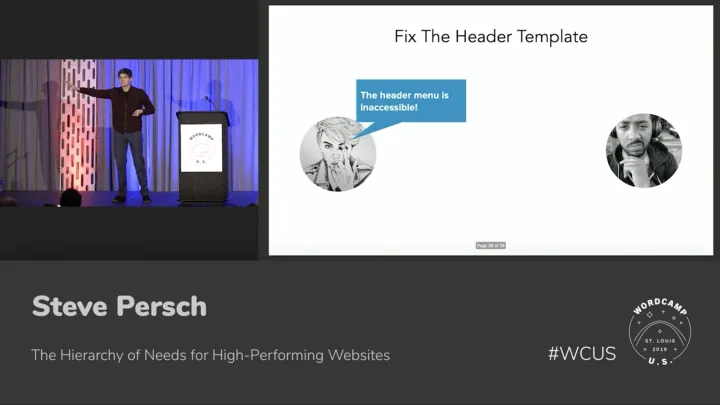I saw the importance of conference and meetup presentations very early in my career. At my first Drupal meetup I informally walked through the sites I had built in Drupal 5 and the guy sitting next to me offered me a job. That felt pretty good. A few months later, I felt way over my head presenting in the Advanced track at DrupalCamp Chicago 2008 on the same billing as major core contributors. Over the years I’ve evolved my approach to conference presentations to lean more on storytelling and the in-person medium. Especially in the pandemic times, gathering IRL calls for IRL modes of communicating. If I want a straight transmission of information, I’d rather watch a YouTube video at 2x speed.
What computer assembles the website? And why does it take so long?
The answers are complicated. At Twin Cities Drupal Camp 2023 I tried to answer.
Why Your Site is Slow
MidCamp 2016
Conway’s law says that “any organization that designs a system (defined broadly) will produce a design whose structure is a copy of the organization's communication structure.” In this presentation and blog post I mapped how a broad set of website performance problems (caching, database queries, unaccountable 3rd party JavaScript files) all have roots in the team dynamics of those building and maintaining a site.
Rendering HTML with Drupal: Past, Present and Future
Twin Cities Drupal Camp 2015
This analysis of shifting patterns in theming and site building in Drupal was the beginning of a trend that I continued after starting at Pantheon (shortly after, and partly because of, this presentation). I think we're most effective as web professionals when see the longer arc of that history.
The Cliff of Complexity
At GatsbyConf 2021 I wanted to highlight a pattern I observed in a lot of Static Site Generator projects. SSG can greatly simplify and speed up development workflows for some web teams and sites. This site you’re reading now has been an SSG a few different times over the years (Jekyll and Gatsby). But after crossing a threshold of one-too-many behavioral requirements, SSG projects can rocket from extraordinarily simple to extraordinarily complex. This presentation also featured my What Computer Assembles the Website question that I have since broken out into its own video with sticky notes and crayons.
IoT & Al Gore
Overcomplicating everything with the Internet of Things
MidCamp 2017
For my last work-task before going on paternity leave I shared my reflections on the blurry line between jokes and tech insights at MidCamp.
That time I gave a DevOpsDays Ignite Talk as Al Gore about IoT
DevOpsDays Minneapolis 2019
Back at DevOps Days Minneapolis 2019 I presented an Ignite Talk in character as former Vice President and Technology Enthusiast, Al Gore.
Mapping the "Hierarchy of Needs" to websites. And then turning it into a drama.
In 2018, at Yale's Digital Summit, I drew parallels between Maslow's Hierarchy of Needs and web development. That idea turned into a dramatized keynote. Then I doubled down and rewrote it in iambic pentameter because... I don't know, YOLO?
The WordPress lightning talk version
Drupal Camp Belarus Keynote
Drupal Camp Belarus 2019
For my first time keynoting, I wanted to do something memorable that would play well across cultural differences.
The seed of the idea
Yale Digital Summit 2018
Humans need food and water. Website servers need electricity and bandwidth. Humans want to belong, websites should stay "on brand."
I think I developed this presentation by sitting motionless on my couch for about 2 hours as I thought it all through. Then it wrote itself.
Conference Hijinx
Automated Testing, Right Now
Too often automated testing feels out of reach (I made a fever-dream video about that). Here are tips for getting a grasp.
1,001 CI Builds: The story of Drupal 7 to 8 migration
DrupalCon Seattle 2019
Rebuilding and migrating a site from Drupal 7 to Drupal 8 took a lot of work. And a lot of CircleCI jobs.
Bending Behat's Benefits: a live coding adventure
MidCamp 2018
Behat is meant for Behavior-Driven Development. It can be bent into a general regression testing tool too. Can it be both?
